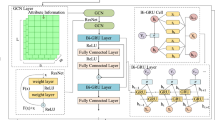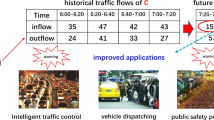Abstract
The prediction of regional traffic flows is important for traffic control and management in an intelligent traffic system. With the help of deep neural networks, the convolutional neural network or residual neural network, which can be applied only to regular grids, is adopted to capture the spatial dependence for flow prediction. However, the obtained regions are always irregular considering the road network and administrative boundaries; thus, dividing the city into grids is inaccurate for prediction. In this paper, we propose a new model based on multi-graph convolutional network and gated recurrent unit (MGCN-GRU) to predict traffic flows for irregular regions. Specifically, we first construct heterogeneous inter-region graphs for a city to reflect the relationships among regions. In each graph, nodes represent the irregular regions and edges represent the relationship types between regions. Then, we propose a multi-graph convolutional network to fuse different inter-region graphs and additional attributes. The GRU is further used to capture the temporal dependence and to predict future traffic flows. Experimental results based on three real-world large-scale datasets (public bicycle system dataset, taxi dataset, and dockless bike-sharing dataset) show that our MGCN-GRU model outperforms a variety of existing methods.
摘要
区域交通流量预测对智能交通系统的交通控制和管理十分重要. 借助深度神经网络, 采用仅适用于规则网格的循环神经网络或残差神经网络捕获流量预测的空间依赖性, . 但是, 考虑到路网和行政边界得到的区域通常是不规则的. 因此将城市划分成网格进行预测是不准确的. 提出一种基于多图卷积网络和门控循环单元 (MGCN-GRU) 的不规则区域交通流量预测模型. 首先, 构建一个城市异质区域间关联图反映各区域间的关联. 在每个图中, 节点表示不规则区域, 边代表区域间的关联类型. 然后, 提出一个多图卷积网络融合不同区域间关联图和附加属性. 进一步采用门控循环单元捕获时序依赖并预测未来交通流量. 实验结果表明, 基于3个真实大数据集 (公共自行车系统数据集、 出租车数据集和无桩共享自行车数据集), 所提MGCN-GRU模型性能优于多个现有方法.
Similar content being viewed by others
References
Box GEP, Jenkins GM, Reinsel GC, 2015. Time Series Analysis: Forecasting and Control. John Wiley & Sons, New York, USA.
Bruna J, Zaremba W, Szlam A, et al., 2014. Spectral networks and locally connected networks on graphs. Proc Int Conf on Learning Representations, p.1–14.
Chai D, Wang LY, Yang Q, 2018. Bike flow prediction with multi-graph convolutional networks. Proc 26th ACM SIGSPATIAL Int Conf on Advances in Geographic Information Systems, p.397–400. https://doi.org/10.1145/3274895.3274896
Chandra SR, Al-Deek H, 2009. Predictions of freeway traffic speeds and volumes using vector autoregressive models. J Intell Transp Syst, 13(2):53–72. https://doi.org/10.1080/15472450902858368
Defferrard M, Bresson X, Vandergheynst P, 2016. Convolutional neural networks on graphs with fast localized spectral filtering. Proc 30th Int Conf on Neural Information Processing Systems, p.3844–3852.
Fu R, Zhang Z, Li L, 2016. Using LSTM and GRU neural network methods for traffic flow prediction. Proc 31st Youth Academic Annual Conf of Chinese Association of Automation, p.324–328. https://doi.org/10.1109/yac.2016.7804912
Kaltenbrunner A, Meza R, Grivolla J, et al., 2010. Urban cycles and mobility patterns: exploring and predicting trends in a bicycle-based public transport system. Perv Mob Comput, 6(4):455–466. https://doi.org/10.1016/j.pmcj.2010.07.002
Kim Y, Wang P, Mihaylova L, 2019. Scalable learning with a structural recurrent neural network for short-term traffic prediction. IEEE Sens J, 19(23):11359–11366. https://doi.org/10.1109/jsen.2019.2933823
Kipf TN, Welling M, 2017. Semi-supervised classification with graph convolutional networks. Proc 5th Int Conf on Learning Representations, p.1–10.
Li YG, Yu R, Shahabi C, et al., 2018. Diffusion convolutional recurrent neural network: data-driven traffic forecasting. Proc 6th Int Conf on Learning Representations, p.1–10.
Monti F, Bronstein MM, Bresson X, 2017. Geometric matrix completion with recurrent multi-graph neural networks. Proc 31st Int Conf on Neural Information Processing Systems, p.3697–3707.
Moreira-Matias L, Gama J, Ferreira M, et al., 2013. Predicting taxi-passenger demand using streaming data. IEEE Trans Intell Transp Syst, 14(3):1393–1402. https://doi.org/10.1109/tits.2013.2262376
Seo Y, Defferrard M, Vandergheynst P, et al., 2018. Structured sequence modeling with graph convolutional recurrent networks. Proc 25th Int Conf on Neural Information, p.362–373. https://doi.org/10.1007/978-3-030-04167-0_33
Tian YX, Pan L, 2015. Predicting short-term traffic flow by long short-term memory recurrent neural network. IEEE Int Conf on Smart City/SocialCom/SustainCom, p.153–158. https://doi.org/10.1109/smartcity.2015.63
Wang P, Kim Y, Vaci L, et al., 2018. Short-term traffic prediction with vicinity Gaussian process in the presence of missing data. Sensor Data Fusion: Trends, Solutions, Applications, p.1–6. https://doi.org/10.1109/sdf.2018.8547118
Williams BM, Hoel LA, 2003. Modeling and forecasting vehicular traffic flow as a seasonal ARIMA process: theoretical basis and empirical results. J Transp Eng, 129(6):664–672.
Yao HX, Wu F, Ke JT, et al., 2018. Deep multi-view spatial-temporal network for taxi demand prediction. Proc 32nd AAAI Conf on Artificial Intelligence, p.2588–2595.
Ying R, He RN, Chen KF, et al., 2018. Graph convolutional neural networks for web-scale recommender systems. Proc 24th ACM SIGKDD Int Conf on Knowledge Discovery & Data Mining, p.974–983. https://doi.org/10.1145/3219819.3219890
Yoon JW, Pinelli F, Calabrese F, 2012. Cityride: a predictive bike sharing journey advisor. Proc 13th Int Conf on Mobile Data Management, p.306–311. https://doi.org/10.1109/mdm.2012.16
Yu B, Yin HT, Zhu ZX, 2018. Spatio-temporal graph convolutional networks: a deep learning framework for traffic forecasting. Proc 27th Int Joint Conf on Artificial Intelligence, p.1–7. https://doi.org/10.24963/ijcai.2018/505
Yu R, Li YG, Shahabi C, et al., 2017. Deep learning: a generic approach for extreme condition traffic forecasting. Proc SIAM Int Conf on Data Mining. p.777–785. https://doi.org/10.1137/1.9781611974973.87
Yuan NJ, Zheng Y, Xie X, et al., 2015. Discovering urban functional zones using latent activity trajectories. IEEE Trans Knowl Data Eng, 27(3):712–725. https://doi.org/10.1109/tkde.2014.2345405
Zhang JB, Zheng Y, Qi DK, et al., 2016. DNN-based prediction model for spatio-temporal data. Proc 24th ACM SIGSPATIAL Int Conf on Advances in Geographic Information Systems, p.92. https://doi.org/10.1145/2996913.2997016
Zhang JB, Zheng Y, Qi DK, et al., 2018. Predicting citywide crowd flows using deep spatio-temporal residual networks. Artif Intell, 259:147–166. https://doi.org/10.1016/j.artint.2018.03.002
Zhao L, Song YJ, Zhang C, et al., 2020. T-GCN: a temporal graph convolutional network for traffic prediction. IEEE Trans Intell Transp Syst, 21(9):3848–3858. https://doi.org/10.1109/tits.2019.2935152
Zhu L, Yu FR, Wang YG, et al., 2019. Big data analytics in intelligent transportation systems: a survey. IEEE Trans Intell Transp Syst, 20(1):383–398. https://doi.org/10.1109/tits.2018.2815678
Author information
Authors and Affiliations
Contributions
Dewen SENG designed the research. Fanshun LV and Ziyi LIANG processed the data and implemented the system. Xiaoying SHI drafted the manuscript. Dewen SENG, Xiaoying SHI, and Qiming FANG revised and finalized the paper.
Corresponding author
Ethics declarations
Dewen SENG, Fanshun LV, Ziyi LIANG, Xiaoying SHI, and Qiming FANG declare that they have no conflict of interest.
Additional information
Project supported by the National Natural Science Foundation of China (No. 61903109) and the Zhejiang Provincial Natural Science Foundation of China (No. LY19F030021)
Rights and permissions
About this article
Cite this article
Seng, D., Lv, F., Liang, Z. et al. Forecasting traffic flows in irregular regions with multi-graph convolutional network and gated recurrent unit. Front Inform Technol Electron Eng 22, 1179–1193 (2021). https://doi.org/10.1631/FITEE.2000243
Received:
Accepted:
Published:
Issue Date:
DOI: https://doi.org/10.1631/FITEE.2000243




